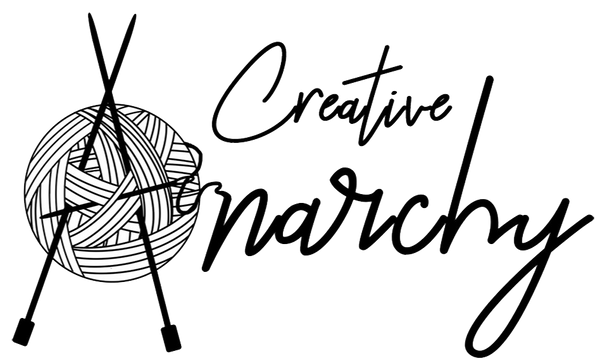So you’ve been knitting a while, you’ve shared some of your photos on social media, maybe started getting some suggested knitting posts on Instagram explore, watched a couple of youtube podcasts, and you’ve seen people rock some amazing knitwear they’ve made using hand dyed yarn. Do a quick check on the yarn they’ve used, and realise that… Wow, that’s expensive. Why could yarn possibly range from a couple of pounds per ball, to around the £20 and above? I’m here to share a few reasons why it’ll cost you more than your average yarn at a regular craft store.
 Skeins of "We Chose to Love" dyed on "Bourgeois"
Skeins of "We Chose to Love" dyed on "Bourgeois"
High quality materials
The chance is that you’re not comparing like-for-like. What’s the kind of yarn you’ve been using up until now? A lot of yarn you find at a craft store is plastic based. So while knitting may seem like a sustainable way of clothing yourself, you’re actually supporting unsustainable business practices that will end up with more microplastics in the ocean every time you wash your lovely knitwear.
Hand dyed yarn on the other hand, is always made using materials with high natural material contents. Most of them will be animal fibre based, like wool, but there are also dyers out there who dye cotton and Tencel (a cellulose based manmade fibre).
Even if you compare natural material commercial yarn with hand dyed yarn, you’ll often find that the quality a hand dyer use is often better. The sheep are treated better, resulting in softer wool, or in the case of mohair, the goats are treated better and the resulting fibre is softer, so you don’t end up with the scratchy effect that cheap mohair gives you.
You will also find that, as long as you treat your knitwear right, it’ll last for years if you use high quality fibres, so you can be guaranteed that your hard work will last for more than a few months of wear. Another bonus effect of using natural fibres like wool, is that you barely have to wash it. Unless you get your knitwear properly messy, you’ll be fine to just leave it out to air every now and then for a few hours. Wool has amazing property that I can go on about forever, but I think we’ll have to save that for a whole other post!
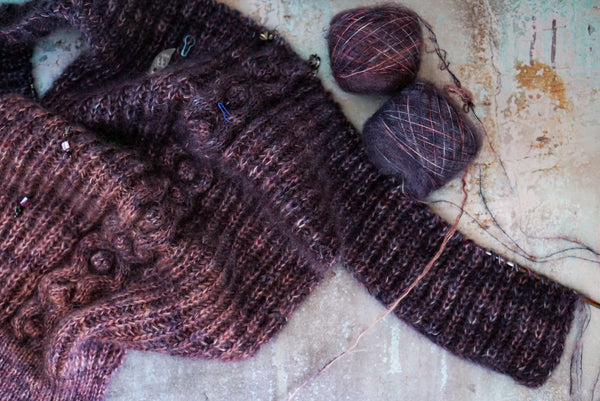 "Space Fade" dyed on "Willow", a mohair base, being knit into a cardigan.
"Space Fade" dyed on "Willow", a mohair base, being knit into a cardigan.
It’s a long process
It may seem like hand dyeing yarn just involves whacking some dye on some yarn and Bob’s your uncle, fancy yarn. In truth, there’s a lot more to it than that. It takes a lot of time, space, and physical work.
- You need to soak your yarn, this takes a few minutes of active time, and anything between 20mins-12 hours of passive time.
- Mixing your dyes. Depending on your methods you’ll need to mix up dyes with water to get the different colours from powder, into a liquid form which we call dye stock. This often involves mixing anything from as few as two different dye powders, to five or six. (At least in my case, I’m sure some dyers use even more!) Variegated yarn use many different dye stocks for different effects, so you’ll end up doing a lot of measuring and mixing!
- Depending on your yarn, the actual dyeing process can take anywhere from half an hour to several hours, with several different layers of dye being added at different stages.
- Once you’ve “finished” dyeing your yarn it needs to be cooled down, washed, and rinsed. This is hard work, yarn gets very heavy when it’s soaked!
- Drying can take forever, especially in England during the winter! Unfortunately you can’t just chuck it in the dryer. I use the spin cycle on my washing machine, detangle the yarn, and hang it up to air dry.
- Twisting and labelling is the final part of the dyeing process, and feels like a full time job in itself. Many dyers do the twisting by hand, but there are special skein twisting machines, although they are very expensive and not an option for many smaller businesses.
All in all, it’s a process that’s very lengthy. Don’t get me wrong, it’s a lot of fun, but it’s definitely labour intensive, and I think people don’t quite realise how much time it actually takes.
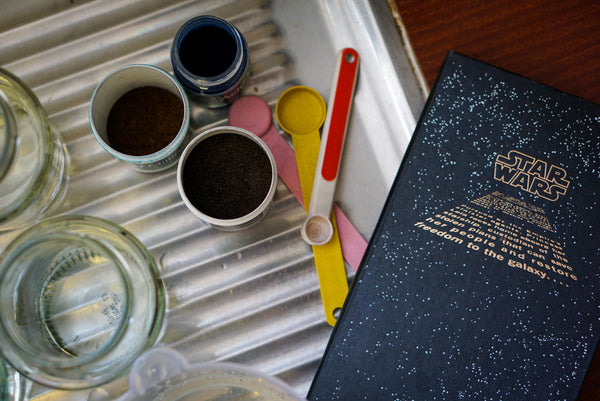 Dyeing equipment and my recipe book, ready for a dyeing session.
Dyeing equipment and my recipe book, ready for a dyeing session.
Small businesses
Most hand dyed yarn companies are small businesses run by women with no helpers. This means that they’re not only hand dyeing yarn, they’re also accountants, marketing managers, website designers, fulfilment centres, photographers, you name it. All of this adds up. You have to remember that you’re not only paying for someone to dye yarn, you’re also paying for all of those other roles.
But that also means that every single time you’re placing an order you’ll have someone on the other end of a laptop or phone screen, doing a little happy dance because someone appreciated the work that they do.
You can also expect a personal touch. Almost every single time I’ve received an order from a small business I’ve had a handwritten note saying thank you, and that’s because we’re all truly grateful for every single order. Of course, this is not the same for every single indie dyer, not everyone has time for that, but they’ll always be packed with love.
Often, you’ll also find that hand dyers are more than happy to give you advice on which yarns will look good together, which of their yarns will work best on your intended project, and generally just want to help.
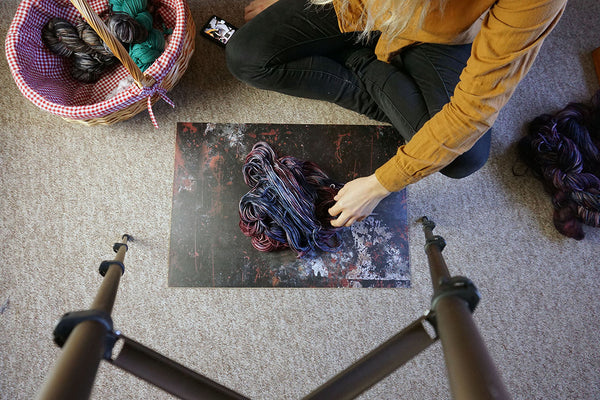 Me playing photographer for a shop update
Me playing photographer for a shop update
How much yarn you get
This may seem like an obvious one – but hand dyed yarn often comes in 100g skeins as standard. Commercial yarns often come in 50g balls, especially the big brands that sell natural fibres. These may appear a lot cheaper as they’re often priced between £6-8, but when you start adding up how much you need for your project, you’ll find that the end price is cheaper, but not drastically cheaper. Some of them even end up more expensive, as the “cool” and “trendy” yarn companies are charging even more, so you’re looking at £20-25 for 100g. I don’t know about you, but I’d much rather support a small business than a trendy corporation!
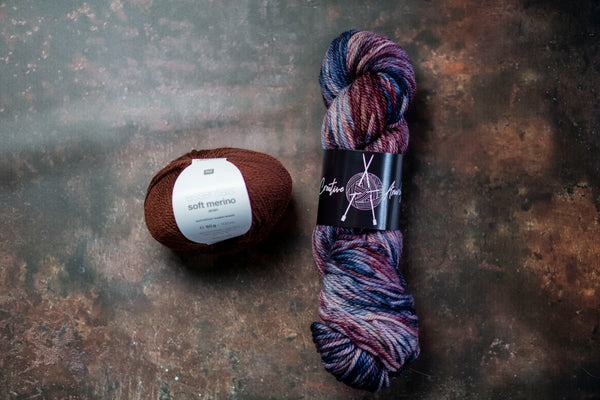 Commercially dyed yarn next to hand dyed yarn
Commercially dyed yarn next to hand dyed yarn
You’re paying for experience and expertise
Finally, you’re not just paying for the above, you’re also paying for the hours of time spent learning. The trial and error, the mistakes, the understanding of which methods works, what colours work well together. Dyeing yarn is easy, dyeing pretty yarn takes practice. Even two years into having my business, and three years into dyeing, I still dye yarn that goes straight in the bargain bin. Not because they’re not pretty – but because they’re not what I’d planned and it doesn’t fit with the rest of my line up!
There’s not a lot of information out there telling you exactly what to do and how to do it, because every single dyer has their own methods, and no method is “correct”. But that also means it takes a lot of practice before you find your voice as a dyer, and not a lot of information on how to achieve the effects you’re trying to create.
 Skeins of "Carnival" and "Kiss the Librarian" dyed on "Comfort"
Skeins of "Carnival" and "Kiss the Librarian" dyed on "Comfort"
So, there you have it
I hope that makes you understand why hand dyed yarn is more expensive than your average commercial yarn. It definitely makes bit more of a dent in your purse, but in my personal opinion, if I’m spending hours and hours knitting on something, I do want it to be perfection in the end, so it’s worth an extra splurge.
But you definitely don’t have to knit using only hand dyed yarn. Another option is to mix and match – there are no rules against combining cheap and expensive yarns, whether it’s in the same project or hopping between a budget project and a project with hand dyed yarn. A great method I recommend is to buy hand dyed mohair, and then pair it with a cheaper fingering weight commercial wool. That way you get the softness, fluff, and fun colours of a hand dyed yarn, but made more affordable by a commercial wool to hold it double with.
Despite being an indie dyer myself, I still mix and match with my own hand dyed yarn, other and dyed yarns, and commercial yarns. I recommend you do the same!
